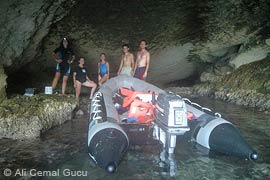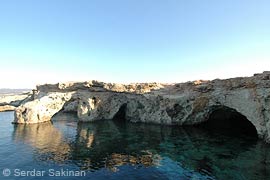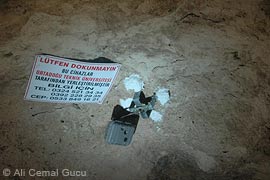

 |
||
 |
||
Vol. 9 (2): November 2006 |
||
Seals of Northern CyprusAli Cemal Gücü, Meltem Ok, Serdar Sakinan, Billur Çelebi, Ekin AkogluMiddle East Technical University Institute of Marine Sciences
|
 |
|
|
Members of the research team on mission. |
Between July 5 and August 5, a team of 9 people – 5 scientists, 2 volunteers and 2 crew – surveyed the entire coast of Northern Cyprus in search of caves that may be used by seals. A total of 40 caves were found during the survey.
In contrast to the coast of the nearest mainland, the topography of the island is not steep enough to form caves with high ceilings. The existence of numerous caves with collapsed ceilings indicates that the geology, combined with high waves in the winter months, seems to play a significant role in a lack of suitable caves.
Another important factor that may hinder cave use was the extreme accumulation of debris, mainly composed of plastic waste, in the caves. Also, several caves having a long and wide beach at their far end and limited air circulation, were filled with Posidonia oceanica remains, that were decaying and releasing potentially irritating sulphurous gases. Leaf shed in sea grass is a natural phenomenon; however such a high level of leaf deposition in a cave has never been observed on the Turkish coast, 40 miles away.
Nevertheless, out of 40 caves discovered, 7 were found appropriate for monitoring and 8 infrared monitors were installed.
 |
 |
|
|
The topography of the island is not steep enough to form caves with high ceilings. |
8 infrared monitors were installed in 7 caves. |
During the first survey, 3 seals were sighted by the team. The first was sighted on the 6th day near the border between the north and the south. However, no picture could be taken due to rough sea conditions and the cautious behaviour of the animal. On the 22nd day, on a very calm morning, when one of the Zodiacs of the team was approaching a series of caves in an area locally called “ancient harbour” (Yeni Erenköy), a form very familiar to the team appeared on the surface. The boat immediately left the area, leaving a team member in the water to collect silently as much information as possible. During almost an hour of hide and seek through the sea grass meadows, the seal posed for a couple of pictures quite sufficient to confirm its identity: an adult male bearing a very conspicuously large scar covering the left half of his posterior. This was a well-known individual frequently sighted on the Turkish coast. The last sighting of “Bombaci” was when he was mating in December 2005.
The team returned to Yesilirmak, where the first seal was sighted, to install the infrared monitors. Almost at the same spot, a seal was sighted again from a distance. The animal displayed the same shy behaviour and disappeared just before the team could reach the triggers of their cameras.
Hence the first part of the survey ended with 3 seal sightings, 40 discovered caves and 8 monitors installed in the most suitable caves.
The team visited the island once again in October 2006. After 2 days lost to clearing customs, the caves determined in the first survey were checked for whelping evidence and the data accumulated in the monitors were retrieved. Though no pup could be found, the results were fruitful, with the monitors able to capture 4 different seals. The first one was Bombaci sighted in the first survey. He was last recorded by the monitors on September 9th and the cave had been abandoned since then.
There were no records of the seal in another cave in the same area, and it may not be pure speculation if the inactivity in the cave is linked to the newly started marina construction just a hundred meters away.
One of the two caves on Yesilirmak was used by a female, having a few mating scars on her belly. The entrance of the neighbouring cave was blocked by a barrier of pebbles deposited by the waves. The monitor installed there was not able to capture a seal, but only a mouse and a couple of fruit bats mating.
 |
|
|
The youngster, caught on camera. |
Three seals were photographed in an underwater cave near the cape of Zafer, one of them being another young female having totally different dorsal markings than the one found in Yesilirmak.
The most exciting moments of the survey are when the data in the monitors, left in the caves to record for 2 months, are retrieved and downloaded to a computer. The capture of a seal image is marvellous compensation for all the efforts spent at sea. The last seal photographed in the survey, was even more than that. A youngster, not older than a year, provided possible evidence of breeding on the island.
The next and the last survey on the island is planned for December 2006. As we have experienced in the nearest colony to Cyprus, December is the end of the whelping season. Therefore the team still hopes to find a newborn pup on the island. The final conclusion will come after that final survey; however it is clear that Cyprus Island has a small breeding colony composed of at least 4 individuals.
Copyright © 2006 Ali Cemal Gücü, Meltem Ok, Serdar Sakinan, Billur Çelebi, Ekin Akoglu, The Monachus Guardian. All Rights Reserved |